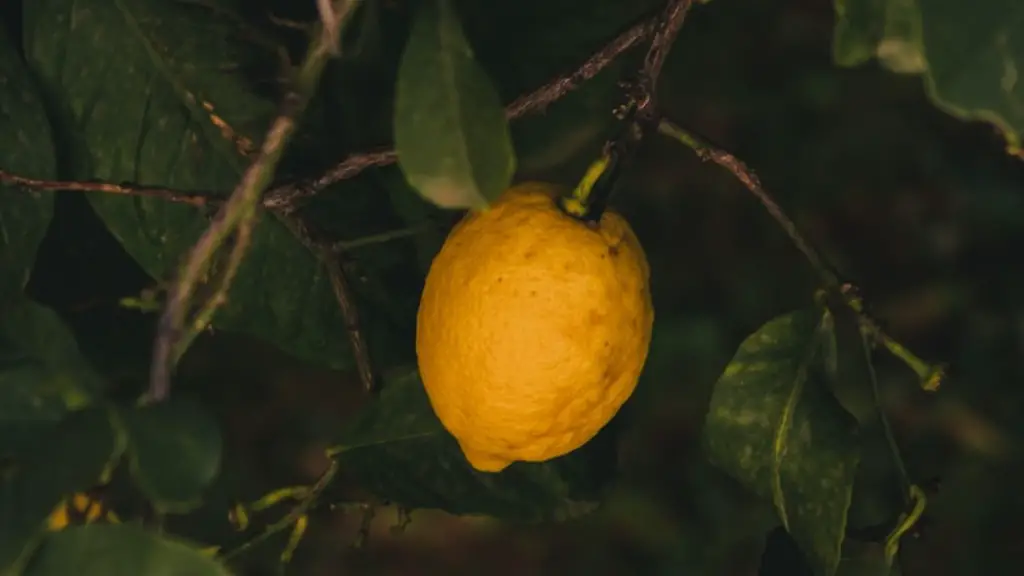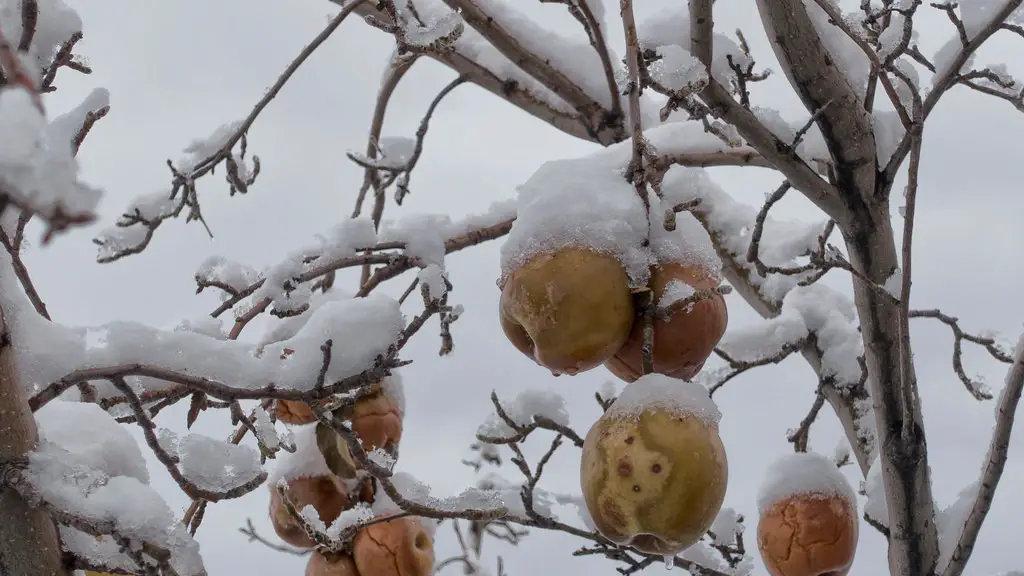Growing Lemon Trees in Oregon
Oregon’s climate isn’t ideal for growing lemon trees; however, some growers find success. Citrus trees favor warmer and sunnier climates and don’t tolerate freezes. Oregon does have a short window of frost free periods during the winter, which gives growers the opportunity to grow fruit trees. It also has mild temperatures and can provide enough warmth throughout the year to properly ripen the fruit.
In order to have a successful lemon crop in Oregon, the following should be taken into consideration: weather, soil, planning, and water. It’s important to have knowledge of Oregon’s winter weather and seasonal cycles, as that will determine when to plant and when to harvest. The soil should also be well-draining, alkaline, and rich in organic matter to foster good root growth. Proper planning should also be done, such as deciding on which varieties to grow and how many trees to plant. The water supply should be regularly monitored to ensure the soil doesn’t become soggy or dry.
When deciding on a suitable spot to plant the lemon trees, you’ll want to be sure to pick an area with ample sunshine and protection from cold, winter winds. Sunlight is just as important as other factors, as the less sunshine a lemon tree gets, the less fruit it produces. It’s also important to allow the trees to become acclimated before planting. So if purchasing from a nursery, allow them to get used to being outside for a few weeks before taking them home.
Oregon does have a short window of frost free periods during the winter and as a result, it is possible to grow lemon trees, but there are other considerations to keep in mind. Proper soil, weather, and water adjustments must be made for a successful crop. If these areas are properly taken care of, then you’ll be able to reap the citrusy rewards of growing a lemon tree in Oregon!
Pruning Lemon Trees in Oregon
Pruning is an important part of managing your lemon tree. Pruning should be kept to a minimum as lemon trees don’t tolerate heavy pruning as much as other citrus trees. Lemon trees should be pruned once a year in late winter or early spring, before the growing season begins. This will encourage new growth and help regulate the size and shape of your tree. When pruning the tree, be sure to remove any dead or diseased branches to promote healthy growth. You should focus on thinning and shaping the canopy, and removing any branches that cross each other or rub up against each other as this can cause damage.
It’s important to use the right tools when pruning. A clean pruning saw should be used to cut through branches, and sharp pruning shears can be used to snip off any small twigs. Pruning shears are especially important for the delicate terminals of the branches, as a regular saw can cause damage to those small, tender branches. If there are any spurs present, those can be pruned out as well. When dealing with thicker branches, it’s important to always cut at a slant so that the branch is not cut too close to the main trunk.
Pruning is an essential part of tree care, as it helps promote growth and keeps the tree healthy. Pruning must be done properly in order to maintain the health of your lemon tree. Keep in mind that lemon trees don’t tolerate heavy pruning, so it is essential to keep the pruning to a minimum. When done properly and at the right times of year, pruning can help you keep your Oregon lemon tree healthy and strong!
Harvesting Lemon Trees in Oregon
Oregon’s climate isn’t ideal for growing lemon trees, but with proper planning and care, a harvestable crop can be produced! Lemon trees usually tend to bear fruit towards the end of summer all the way to the beginning of fall, this varies depending on what type of tree you’re growing and the local climate. A good indicator of when the fruit is ready for picking is when the top of the fruit turns yellow and it begins to separate from the branch easily.
When harvesting your lemons, be sure to use a ladder and pruners. Proper safety should be taken into account when using a ladder and when harvesting the fruit. When cutting the fruit, you should use proper pruning practices such as cutting at a slant to allow new growth. When you’re done harvesting, you should use the same pruning shears to snip off any dead or diseased branches. Be sure not to over-harvest your tree, as it can place unnecessary stress on the branches and can lead to undesired consequences.
Harvesting a lemon tree in Oregon can be done but requires knowledge and patience. If done properly, the lemon tree can produce a great haul of lemons. As always, safety should be taken into account when harvesting and when caring for the tree. With some effort, you should be able to enjoy a nice harvest of lemons from your Oregon lemon tree!
Feeding Lemon Trees in Oregon
Feeding your lemon tree is essential for it to are properly. Lemon trees prefer a soil high in organic matter, so a fertilizer should be used every few months to add nutrients back into the soil. Fertilizers can be organic or commercial, however they should contain a balance of nitrogen, phosphorous, and potassium. Fertilizers created specifically for citrus trees are more preferable, as they contain micronutrients that help with root and leaf growth. Be sure not to overfertilize, as this can cause the soil to become acidic and burn the roots.
When fertilizer is applied, also keep in mind proper watering techniques. While the soil should be kept evenly moist, it should be watered in moderation as too much water can cause the tree to become overly saturated. When the soil around the tree is properly fertilized and watered, the tree should grow healthy roots and be able to absorb nutrients better.
A proper feeding schedule is important when growing a lemon tree in Oregon. Consistent fertilizing and proper watering ensures the tree will be able to take in the necessary nutrients and grow strong and healthy. This can be done with organic or commercial fertilizers, and with the right balance of phosphorous, nitrogen, and potassium. When feeding your tree, keep in mind that moderation is key and overfertilizing can burn the roots. With the right technique, you’ll be able to ensure your Oregon lemon tree receives proper feeding!
Caring for Lemon Trees in Oregon
Caring for your lemon tree in Oregon is essential for a healthy and happy tree. As with any tree, there are a few basic care requirements such as proper planting, fertilization, and watering. In order to successfully grow your lemon tree in Oregon, its important to know the local climate and seasonal cycles. Lemon trees need to be exposed to a good amount of sunshine, so it’s important to pick a spot where your tree will receive ample sun.
A good soil is also important for the health of your tree. Soil should be well-draining, alkaline, and rich in organic matter. Fertilizing and watering should also be done consistently to provide the tree with the necessary nutrients to grow strong and healthy roots. The soil should be kept evenly moist, but not too wet as it can cause the tree to become overly saturated. Lastly, it’s important to prune your lemon tree at least once a year in late winter or early spring to promote new growth.
Caring for a lemon tree in Oregon is essential for it to produce fruit. Proper soil, watering, and fertilization should be done regularly to ensure the tree receives the proper nutrients. Pruning should also be done once a year in winter or spring to encourage new growth. Properly caring for your tree will keep it happy and healthy and lead to a great harvest of lemons from your Oregon lemon tree!
Protection for Lemon Trees in Oregon
Protecting your lemon tree from extreme temperatures and pests is essential when growing your tree in Oregon. Temperatures should be watched as lemon trees do not like temperatures below 28-30 degrees Fahrenheit and should be brought indoors if there is a risk of a hard frost. If not, covering them with blankets can help protect them and they still require six or more hours of sunlight a day to thrive.
In terms of pests, there are a few to keep an eye out for. In the early spring, aphids can appear and can be treated with an insecticidal soap or spray. Mites can also manifest during this season, and can be treated with a mixture of natural and commercial oils to reduce their population. During the fall season, mealybugs can appear and can be treated with insecticidal soaps or sprays, as well.
Protecting your lemon tree from extreme temperatures and pests is key to having a successful crop in Oregon. When temperatures get too low, you should either bring the tree indoors or cover it with blankets, and pests should be dealt with as soon as they are spotted. With proper protection methods in place, your lemon tree should be able to thrive and produce a great harvest of lemons in Oregon!




